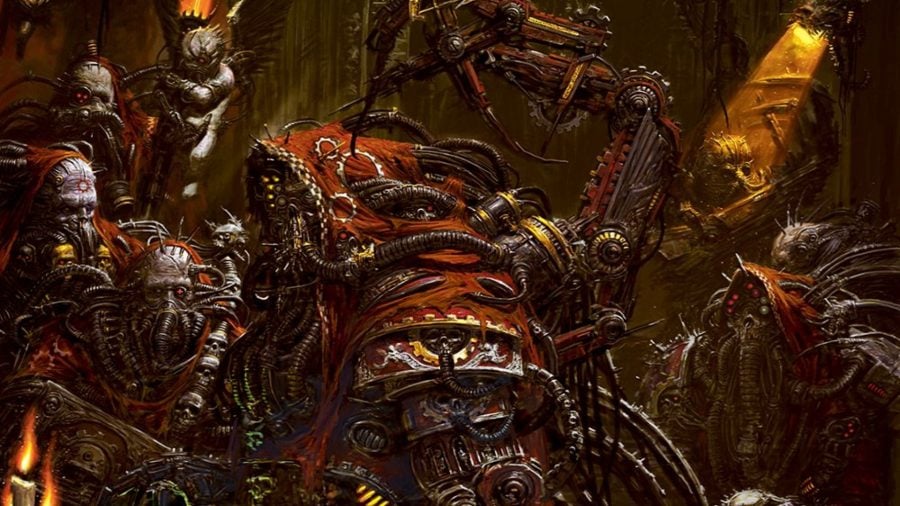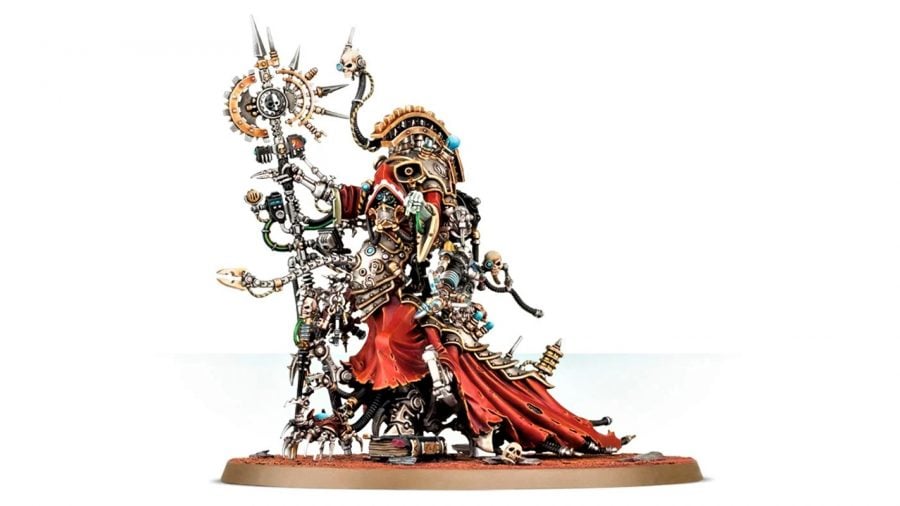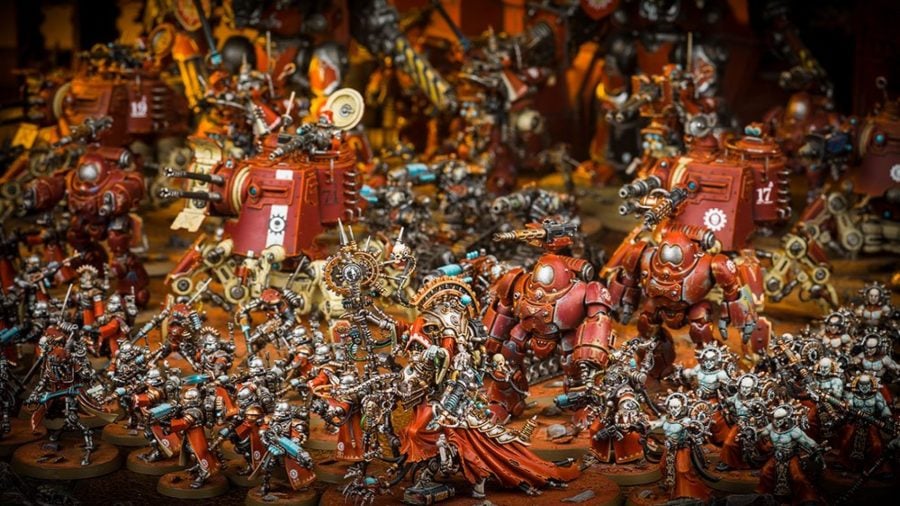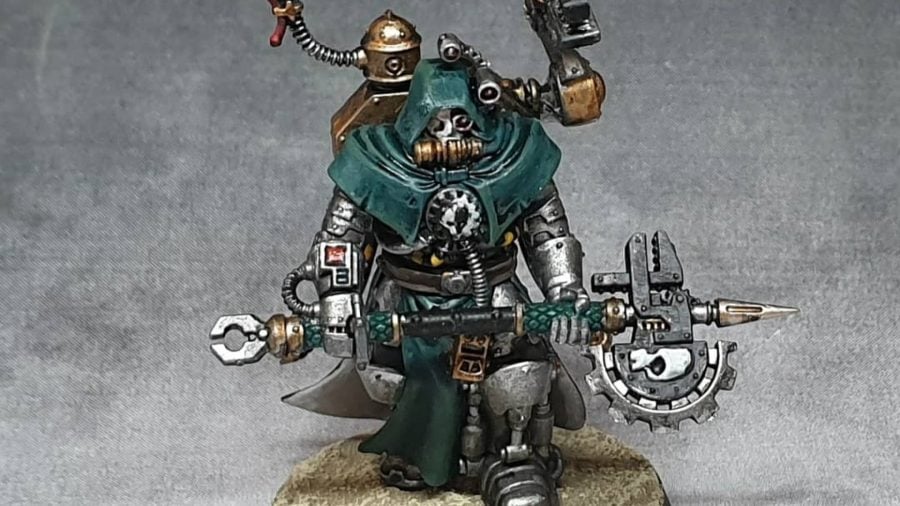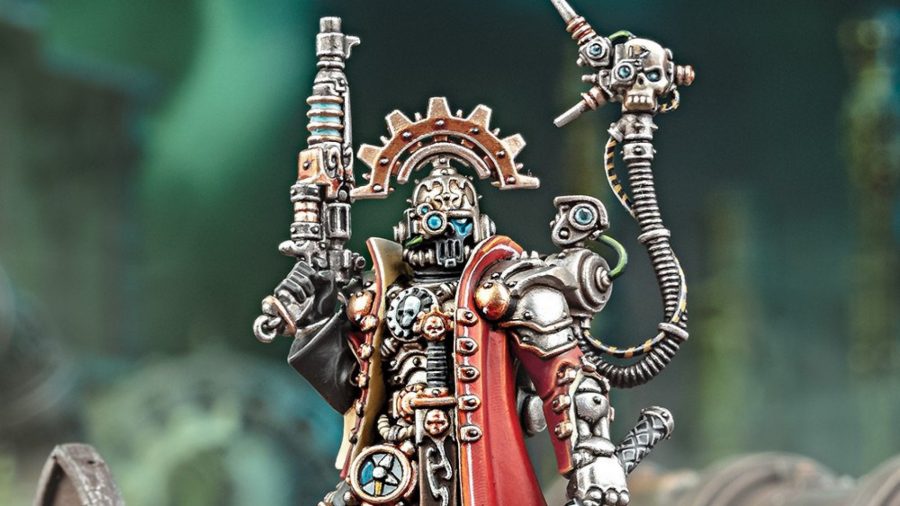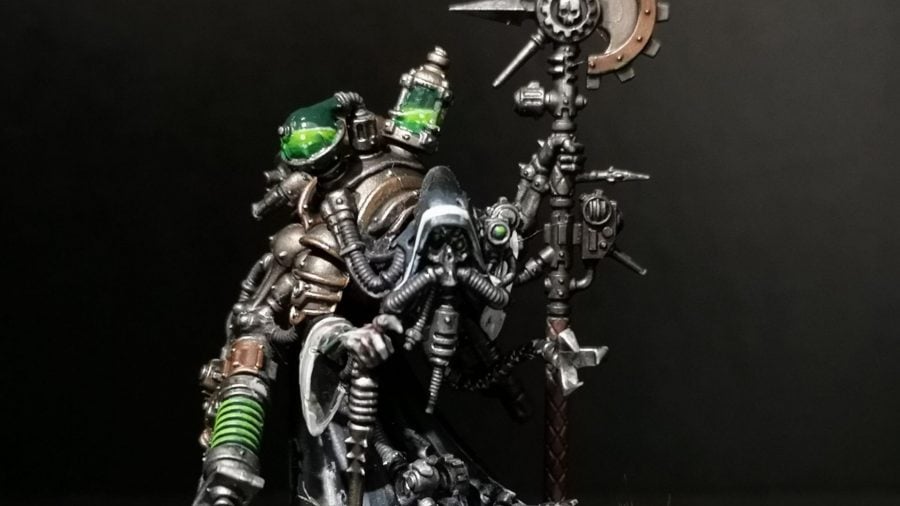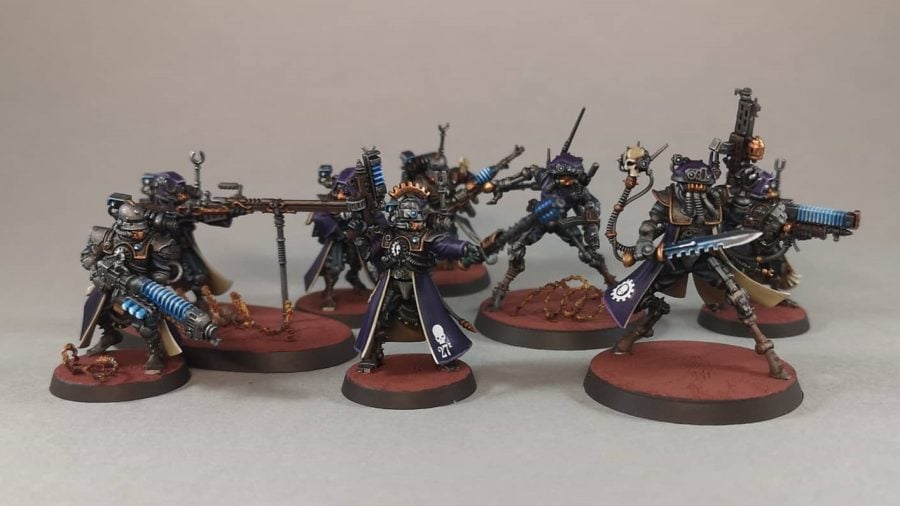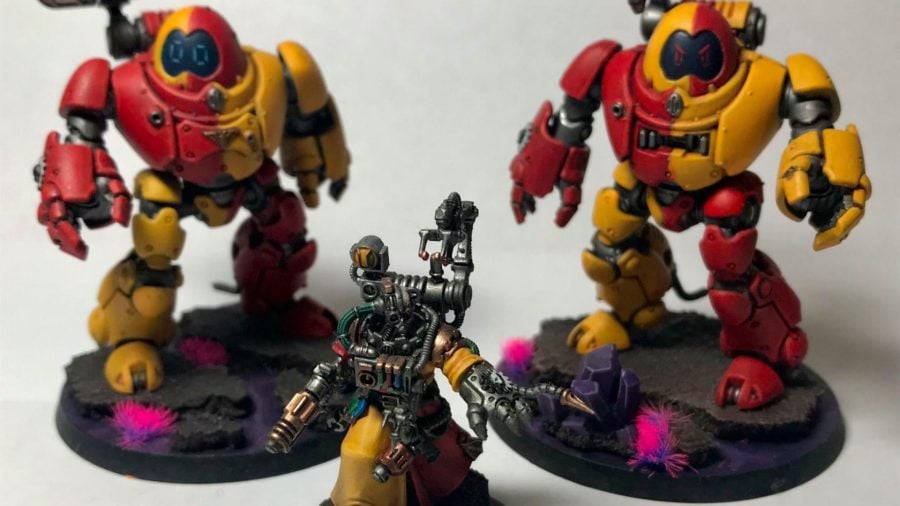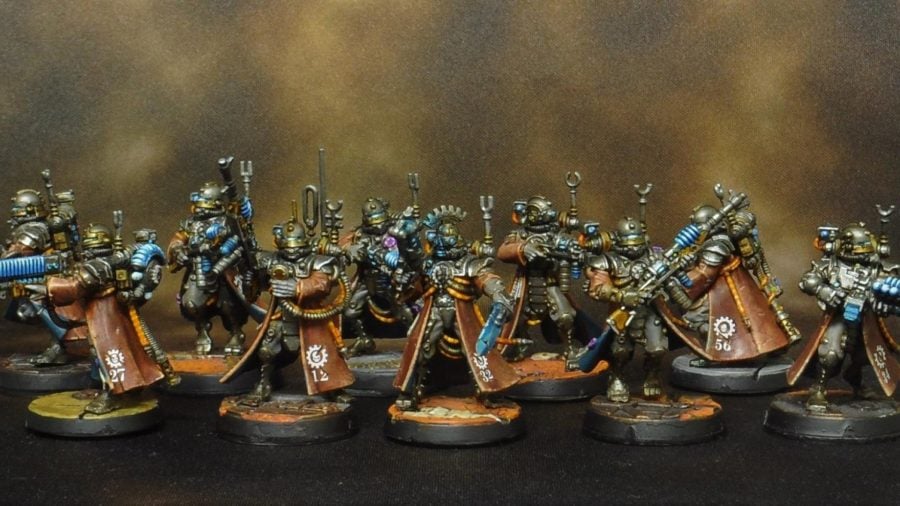Warhammer 40k 9th Edition’s Adeptus Mechanicus faction might be the most inhuman, contradictory offshoot of the human species in the Dark Millennium of Warhammer 40k – and their newest rules are far from child’s play. Nevertheless, our guide should give you a firm grounding in both their techno-mystical lore, and their powerful complexity on the modern, 9th Edition 40k tabletop.
But who are these confounding, chrome-limbed enigmas? Though the AdMech prize logic and calculation, and deride emotion, they are driven by a fanatical devotion to the cult of the Machine God. They are the custodians of mankind’s technology and knowledge, yet these invaluable secrets are cloaked in ritual and mystery. They abhor the alien for its deviance from the holy human form, but spend their unnaturally extended lives purging their bodies of weak flesh and replacing it with cold metal.
An Adeptus Mechanicus army is a holy crusade of fanatically devout warriors, wielding arcane superweapons that rain the wrath of their beloved Omnissiah onto their enemies. On the tabletop, this is represented by – arguably – the coolest model line in all 40k: quad-limbed Onager Dunecrawlers sporting huge Neutron Lasers march to war, thronged on all sides by masses of irradiated Skitarii Vanguard infantry. Talons of Pteraxii Sterylizors descend on bionic wings to scorch their foes with cleansing flame. Cybernetica Datasmiths inload their Kastelan Robot charges with new war codes, while Kataphron Destroyer servitors rumble forwards on heavy tracks to bring immense weapons to bear on the foe.
If you want an imposing, flexible, and customisable army that packs serious firepower, look no further than the Adeptus Mechanicus.
Adeptus Mechanicus lore
The Adeptus Mechanicus predates the Imperium of Man. Though holy Mars was terraformed in ages long past, the planet was consumed by industry, choked beneath the radiation and waste of a million forges, and the aftermath of ancient wars. During the long Age of Strife, when the first human galactic civilisation was torn apart by Warp storms and preyed upon by alien and daemonic horrors, on the red planet, technology meant life. Soon a cult of machine worship took hold. Mars was the first Forge World, and its fabricator-kings became the Mechanicum.
Ancient Martian explorers settled the first Forge Worlds
Throughout the long Age of Strife, Mars sent out explorator fleets in a blind attempt to regain contact with lost human colonies and build new dominions. A precious few of these would survive, seeding new Forge Worlds in the image of Mars – each of which would go on to develop their own cultures and variants on the Martian Creed.
When the Emperor first conquered Terra and initiated the Great Crusade, Mars was brought into the Imperium as a vassal state. In exchange for providing the ships, arms, and armour needed by the great warhosts of the Imperial Army and Legiones Astartes, Mars was offered control of the human technology it recovered. This alliance was shattered during the Horus Heresy, as half of the Mechanicum was lured to the cause of the traitors by Chaos’ promises of forbidden, arcane technology. During this great cataclysm, treasure troves of knowledge and artifice were lost, annihilated in the fires of treachery, and even Mars itself became a boiling cauldron of internecine strife.
During the Heresy, the loyal elements of the Mechanicum reformed into the Adeptus Mechanicus. Though they are bonded closely to the Imperium of Man, and their highest official, the Fabricator General of Mars, holds a permanent position as one of the twelve High Lords of the Imperium, they are still a culture apart. Their devotion to the Emperor is in his aspect as the Omnissiah, corporeal embodiment of the Machine God. Their commitment to the wars of man is for the preservation and recovery of ancient technology, not the defence of human lives.
Knight riders: Read our guide to Warhammer 40k’s Dark Angels
Indeed, the Adeptus Mechanicus have a callous disregard for human life, but a holy reverence for the machine. For them, all technology is an expression of the will and eminence of the Machine God, and the operation of everything, from physics to biology, is an expression of His divine Motive Force. They see themselves as advancing a great work, bringing about a perfect mechanical creation. It does not matter to them how many billions of humans die in service to that vision.
Adeptus Mechanicus characters – BELISARIUS CAWL
There’s only one Adeptus Mechanicus special character model, but he casts a long shadow – and not just because his body is a cybernetic centipede over 10 feet tall.
No Tech-Priest, save perhaps the Fabricator General of Mars, has put their maker’s mark on Warhammer 40k’s current narrative cycle – the Era Indomitus – as firmly as has Belisarius Cawl.
Long ago, in the wake of the Horus Heresy, the Imperial Regent Roboute Guilliman tasked Cawl with a project of dread importance. For the next ten millennia, Cawl worked in secret, using genetic lore from the Emperor’s Primarch project and his own techno-archeological discoveries, in order to found the mighty warhost of the Primaris Space Marines.
Only with the resurrection of Guilliman, and the coming of the Great Rift, has Cawl finally unleashed these upgraded warriors in aid of the Imperium. In short: all the shiny new Space Marine vehicles and weaponry that have been released since eighth edition dropped in 2017 are the product of Belisarius Cawl’s mad genius.
Cawl has always been a borderline heretical figure
Cawl has changed a lot in the 10,000 or more years of his life, literally losing his mind (or at least some of his ancillary data-stacks) several times, but he’s always been arrogant – and borderline heretical – in his willingness to experiment with holy technology. You can learn more about him as a young man in Wolfsbane, book 49 in the Horus Heresy series, or his exploits in the Era Indomitus in The Great Work. You’ve got to admire his confidence: The Great Work involves a heist on a Necron tomb complex, right under the noses of a Genestealer infestation. He’s certainly got big ball bearings.
Playing Adeptus Mechanicus in 9th Edition
The Adeptus Mechanicus may be the most complex army in 9th Edition 40k, as befits the Imperium’s masters of arcane technology. They’re a quantum swiss army knife, able to respond to any battlefield situation (provided you can find the right tool in your packed toolbox) but vulnerable when they bring a transonic razor to a plasma fusil fight.
Tombs awaken: Our guide to Warhammer 40k’s Necrons faction
Even if you’re an experienced 40k player, you should write a cheat sheet of the combos your list can pull off, and what options are at your mechadendrites when a particular scenario arises on the tabletop.
Skitarii and Cult Mechanicus
The warhost of the Adeptus Mechanicus is divided between two forces. The priesthood of the Cult Mechanicus contains most of the army’s HQ choices, as well as the Kataphron Destroyers and Breachers (Troops), Kastelan Robots (Heavy Support), and Fulgurite and Corpuscarii Electro-Priests (Elites).
Skitarii operate more like a regular army (by 40k standards)
The Skitarii, meanwhile, are more like a regular army – albeit one heavily adapted by cyborg adaptation – and can field everything you would expect in a mixed arms force: light infantry, ground transports, tanks, air support, jump troops, infiltration specialists, and dragoons riding cyborg hounds or walking ballistae. OK, so that’s not a normal mixed arms force, but this is the 41st millennium.
If your army is entirely made up of Adeptus Mechanicus units (excluding Imperial Agents, Knight of the Cog Imperial Knights, or unaligned structures) it will gain two benefits: Canticles of the Omnissiah and Doctrina Imperatives. The Canticles are prayers of binharic praise sung by Cult Mechanicus units, while the Doctrina Imperatives are different subroutines broadcast across the Skitarii forces by their commanders.
Canticles of the Omnissiah and Doctrina Imperatives
At the start of each battle round, you can select one Canticle that hasn’t yet been chosen. Its benefits apply to all Cult Mechanicus units. Shroudpsalm, for example, gives units the benefits of Light Cover – an easy choice for early in the game, when your opponent will have most of their guns intact, and will not yet have closed the distance to engage in combat.
Deep blue: Read our guide to Warhammer 40k’s Ultramarines
Likewise, at the start of the battle round, you can pick a Doctrina Imperative that hasn’t yet been used, though there must be at least one HQ choice on the field to assemble and relay the code to their troops. Each Imperative has both a positive and negative side, buffing one stat and reducing another. Bulwark Imperative, for example, improves armour saves and decreases movement, and so is best employed after you’ve moved into position to secure key objectives – while Protector Imperative optimises ranged accuracy, at the expense of melee.
You can run an army of only Skitarii – limiting you to just the Skitarii Marshal for your HQ choice – or run purely Cult Mechanicus, in which case you’ll need to use Kataphron Breachers or Kataphron Destroyers as troops. Either choice will simplify your army, but also greatly decrease your tactical flexibility.
If you’re committed to a pure Cult Mechanicus army, however, you do gain the option to take the Mechanicus Defence Cohort found in Warzone Charadon Act 1: The Book of Rust. This makes your Kataphrons and Kastelan Robots more effective at holding objectives, and reduces all damage they receive by 1, a huge defensive boost – though they will also lose their Forgeworld Dogma. Speaking of…
Forge World Dogmas
Each of the Forge Worlds has their own interpretation of the Mechanicus Creed, reflected on the tabletop by their different ways of making war. Models from that subfaction gain a specific Dogma bonus, which provides unique abilities, as well as access to a unique relic, Warlord trait and stratagem.
It’s early in the lifespan of the codex, so it’s hard to pick a clear leader yet, but Lucius looks promising. Their dogma, Solar Blessings, provides +1 armour save against weapons with a damage characteristic of 1 /and/ adds 3” to the range of all weapons. The denizens of Lucius are also masters of teleportation technology, and, with the Legio Teleportarium stratagem, they can deploy any non-vehicle unit anywhere on the battlefield, 9” from the enemy, for a single command point.
Heretics ahoy: Our guide to Warhammer 40k’s Chaos factions
Meanwhile, their relic The Solar Flare allows the bearer and a nearby unit to disappear from the battlefield and reappear 9” away from an enemy unit – this isn’t a Fall Back move, either, so it’s perfect to disengage from combat and free up those lethal guns for another round of shooting. Their custom warlord trait Luminescent Blessing protects a single friendly unit each round from being wounded on wound rolls of 1-3 – an incredible boost to the survivability of your fragile Skitarii troops.
For traditionalists, the Martian dogma Masters of the Forge extends the Canticles of the Omnissiah ability to include Skitarii units, and provides every unit a free reroll to hit in each phase. They also have the awesome Wrath of Mars stratagem, which grants a unit the ability to cause a mortal wound for each wound roll of 6 when it attacks, to a maximum of 6 mortal wounds. This pairs well with any weapon that brings a mass of attacks; the Assault 5, S3, AP0, damage 1 flechette weapons carried by Sicarian Infiltrators and Pteraxii Skystalkers will suddenly become a credible threat to elite infantry and vehicles alike.
Adeptus Mechanicus HQ – powerful leaders
You’ll have a busy Command Phase with your Adeptus Mechanicus, as each of your characters has at least one ability to trigger, and can pick up extra ones with warlord traits, or by induction to a Holy Order (more on these in a moment).
The new Skitarii Marshal is a cheap and useful HQ choice
Every Cult Mechanicus character has the ability to heal a unit by d3 wounds with the Master of Machines ability, or a flat 3 if they have the Necromechanic warlord trait. This goes some way to mitigating the relative frailty of Adeptus Mechanicus units.
The recently added Skitarii Marshal is a cheap and useful HQ choice. Their aura ability Servo-Skull Uplink provides nearby Skitarii rerolls of 1 to wound, and this can be upgraded with the Exemplar’s Eternity relic to also allow rerolls of 1 to hit. Meanwhile, their Command Edict ability allows one Skitarii core unit within 6” (or attached to the noosphere by a data tether) to ignore the negative effect of their Doctrina Imperative. Their bespoke warlord traits all provide buffs to Skitarii core units: Eyes of the Omnissiah provides re-rolls to advance and charge rolls for a single unit, a great fit for Sicarian Ruststalkers or Sydonian Dragoons.
Holy Orders
As well as their native abilities, Adeptus Mechanicus Tech-Priest units can be inducted to a Holy Order for a small points increase. This is amply rewarded. The Orders each give a once-per-game rebate of one command point to a particular category of Stratagems, plus an ability to buff up a friendly unit in the command phase. More than that, you can then use the Activate Advanced Protocols action to swap out that basic buff for a different one, in-game. Yes, you will want to keep notes and refresh yourself on the Actions rules. Often.
Do it by the book: Our guide to all 40k 9th Edition codexes
The Order of the Logi is easy to recommend: the initial part of their ability provides a Core unit within 6” the ability to treat enemy attacks with AP-1 and AP-2 as AP0 until the next command phase: the advanced part allows a unit to ignore the effects of cover when attacking enemies. Frankly, I don’t see myself leaving the initial part.
Fielding Belisarius Cawl
Belisarius Cawl is a Supreme Commander and special character choice for Mars forces, and he’s fittingly a beast on the tabletop. Armed to the teeth with the finest guns and weapons available to the forges of Mars, such as the Solar Atomiser (12”, Assault d3 Blast, S10, AP -4, Damage D3 or D3+3 against targets within 6”), he also packs a suite of command abilities. The Lord of Mars ability allows him to pick a Mars Core unit within 6” and grant them rerolls to hit until your next turn, while Lead in Prayer allows Cawl himself and one Cult Mechanicus Core unit within 6” to benefit from a different Canticle of the Omnissiah from the rest of your army, including Canticles that have already been used.
Adeptus Mechanicus infantry
The ninth edition codex allows Skitarii Vanguard and Rangers to be brought in blocks of 20, for a mere 160 points (before upgrades). With toughness 3 and a 4+/6++ save, they are not natively very survivable, though the Stygies VIII dogma Shroud Protocols (which gives them Dense Cover against attacks made from more than 12” away) will improve that, as will judicious application of the Bulwark Imperative or the Firepoint Telemetry Cache Skitarii warlord stratagem.
Once stuck on an objective, the Acquisition at Any Cost stratagem will guarantee these folks do not run away, even in the face of crippling casualties. And there are many, many ways to turn their already considerable small arms firepower into an eviscerating volley that few can survive. Start with the Omniscope upgrade, which, for a mere five points, allows the whole unit to ignore Light Cover when making attacks on enemy units.
Infantry precision: Our guide to Warhammer 40k detachments
The Enriched Rounds stratagem costs a single command point, and allows radium weapons to wound non-vehicle units on hit rolls of 4+. That means 20 Vanguard with radium carbines will score, on average, 30 wounds against any non-vehicle target, whether that’s a single Grot, the Daemon Primarch Mortarion, or a Tyranid biotitan.
Galvanic Volley Fire costs 2CP, but doubles the shooting output of Skitarii Rangers by changing their galvanic rifles from Range 30”, Heavy 2, S4, AP-1, Damage 1, to Rapid Fire 2. This plays beautifully with Forgeworld Agripinaa, whose Staunch Defenders Dogma increases their armour penetration characteristic by one against targets within half range of their ranged weapons, and can be pushed even further by the Galvanic Field ability of a Tech-Priest Manipulus, which increases the range of Galvanic, Arc or Radium weapons by 6” and adds 1 to their Armour penetration. 80 S4, AP-3 attacks at 18” range, anyone?
Adeptus Mechanicus weapons – big guns never tire
The Adeptus Mechanicus are blessed with an abundance of specialised, sanctified weapons with which to scorch, electrocute, and irradiate the foes of the Omnissiah.
- Radium weaponry automatically wounds non-vehicle models on a hit roll of 6.
- Arc weaponry has increased damage against vehicles and always wounds them on a 4+ or better, irrespective of strength and toughness.
- Phosphor weapons ignore the effects of dense cover.
- Taser weapons score two additional hits on a to-hit roll of 6.
- Cognis weapons, like the Cognis Lascannon or Cognis Autocannon, are superior to their ordinary Imperial counterparts, boasting the Assault weapon type, and greater rate of fire or increased damage.
That’s just scratching the surface. Kataphron Breacher and Kataphron Destroyer servitors are Troops choices, but they pack the kind of heavy weaponry most armies reserve for their Heavy Support slots. The Transuranic Arquebus is a S7, AP-2, Damage D3 heavy weapon option for Skitarii Rangers and Vanguard. Despite packing anti-tank firepower, it can target enemy characters even when they’re benefitting from the Look Out Sir! rule.
Though Onager Dune-Crawlers carry the faction’s most intimidating weaponry, in the form of the Neutron Laser (48” range, Heavy d3 blast, S12, AP -4, Damage D3+3), the Ironstrider Ballistarii might be the faction’s go-to tank killer. 75 points gets you a M10”, BS3+, T6, W6 frame sporting a Range 48”, Assault 2, S9, AP -3, Damage D3+3 Twin Cognis Lascannon – and Ironstriders can be brought in units of up to 6. There’s nowhere on the battlefield these leggy monstrosities can’t reach out and hurt, and their low points-cost-to-damage ratio makes them a compelling answer to the dreaded Drukhari Raider.
Waging war as the Adeptus Mechanicus
The Adeptus Mechanicus’ greatest strength is their flexibility. Though you’ll always have a core of ranged weapons, it’s possible to build a nimble, elusive force full of Pteraxii, Cerberus, Ironstrider and Sicarian units, or a melee force of Electro-priests, Sydonian Dragoons and Kastelan Robots armed with giant robot fists. Each round, you’ll make choices about how to retool your forces, one moment blunting an enemy melee assault with Litany of the Electromancer, the next giving your Skitarii a sudden burst of speed with the Aggressor Imperative to capture an unguarded objective.
Your complex buffs and abilities are both strength and weakness
This is also your weakness. Much of your strength comes from buffs that can be peeled away if you lose your HQ models. Though the right buff at the right time will make your troops perform well above their weight class, you really need those buffs to succeed, and the wrong pick will leave you vulnerable and exposed. A diverse army will have the tools to answer any threat – but that comes with increased complexity. As your deck of tricks is depleted, and your specialised units are destroyed, you’ll find that you have to push a square macroinduction coil into a round data-communion port.
Only an insane genius could dream up such a powerful, intricate, complex war machine. But that’s the fun of playing Adeptus Mechanicus.
With thanks to Mark Bushell for his fantastic dark-robed Dominus, Nerodine for his gorgeous Vanguard unit, Heather’s fetching dark jet tech-priest, JB for his impressive quartered red and yellow robots, and Pandaemonium Miniatures Paul’s sinister purple Skitarii.
Source: Wargamer





